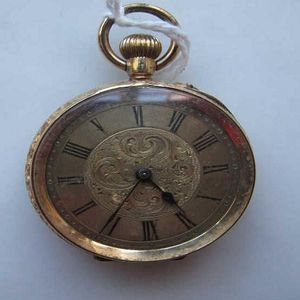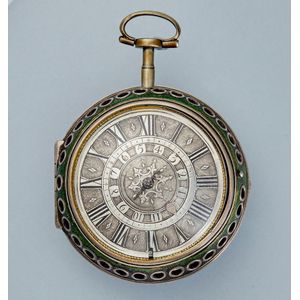18th Century Shagreen and Silver Alarm Watch
You must be a subscriber, and be logged in to view price and dealer details.
Subscribe Now to view actual auction price for this item
When you subscribe, you have the option of setting the currency in which to display prices to $Au, $US, $NZ or Stg.
- Gilding - Gilding is a method of ornamentation whereby a thin sheet of gold metal is applied to items made of wood, leather, ceramics, glass and silver for decorative purposes.
For furniture including mirrors, the sheet of gold is usually applied over a coating of gesso. Gesso is a mixture of plaster of Paris and gypsum mixed with water and then applied to the carved wooden frames of mirrors and picture frames as a base for applying the gold leaf. After numerous coats of gesso have been applied, allowed to dry and then sanded a coat of "bole", a usually red coloured mixture of clay and glue is brushed on and allowed to dry, after which the gold leaf is applied. Over time parts of the gilding will rub off so the base colour can be seen. In water gilding, this was generally a blue colour, while in oil gilding, the under layer was often yellow. In Victorian times, gilders frequently used red as a pigment beneath the gold leaf.
Metal was often gilded by a process known as fire gilding. Gold mixed with mercury was applied and heated, causing the mercury to evaporate, the long-term effect of which was to kill or disable the craftsman or woman from mercury poisoning. The pursuit of beauty has claimed many victims, not the least of which were the artists who made those pieces so highly sought after today. - Bezel - On a clock or watch, the bezel is the metal frame into which the watch or clock glass is fitted. In clocks, the bezel may include a hinge and a flange, in effect a door to the face of the clock. In jewellery the bezel is a band of metal with a projecting lip that holds the gemstone in its setting.
- Fusee - The fusee movement was used in clocks and pocket watches from the mid 17th century. The fusee is a cone shaped drum within the works that is linked to the barrel of the spring, usually by a length of chain.
As the mainspring loses its tension over time, the cone shaped barrel compensates for this by increasing the tension, by pulling the mainspring tighter, thus ensuring the time remains constant.
Use of the fusee in clocks was superseded by the "going barrel" in the mid 19th century and for pocket watches at the beginning of the 19th century.
The fusee continued to be used in marine chronometers until the 1970s. - Shagreen - Shagreen is the untanned smoothly pebbled textured skins of rays, sharks or dogfish. In finishing, it is dyed, mostly green, but the colour often fades to a cream colour. Shagreen was a popular material in Europe during the Art Deco era, when designers sought to mould the French tradition of luxury with exotic and precious materials. Most collectable items made from shagreen are smaller objects, like glasses cases, dagger and sword hilts, dressing accessories, boxes and picture frames.
- Verge Escapement - A verge escapement is an early mechanical escapement used in clocks and other timekeeping devices. It is an early form of the escapement mechanism, which is used to regulate the movement of the hands of a clock or watch. The verge escapement consists of a vertical shaft called the verge, which is mounted on the clock's main plate. Attached to the verge are two pallets, which engage with the teeth of the escape wheel. As the escape wheel turns, the pallets alternately lock and release it, allowing the movement of the clock to be regulated. The verge escapement was widely used in early mechanical clocks, but it was eventually replaced by the more accurate and reliable anchor escapement.
- Subsidiary Dial - On a clock or watch, a subsidiary dial, also called an auxiliary dial, is a dial that is secondary to the main dial and may show seconds, day of the week or month, or strike silent. A subsidiary dial may be within our outside the main dial, and a clock or watch may have several subsidiary dials.
- Movement - The technical name for the workings of a clock or watch, and does not include the dial or case.
This item has been included into following indexes:
- clocks, type - alarm and bedside 69
-
pocket watches, case type
- open face, silver case 570
- pair cased 165
- pocket watches, period - Georgian 289
- shagreen items 122
Visually similar items

Antique 18kt gold ladies pocket watch works

18ct open face fob watch fancy gilt dial and engraved back cover, lever wind Check chain

Paul Beauvais London. A silver quarter repeating verge watch with alarm mvt 539 English circa 1730, gilt full plate movement signed and numbered Paul Beauvais, London no. 539, verge fusee escapement, pierced floral engraved balance cock, a mask at the neck

John Wilter London. A silver and polychrome enamel pair cased verge watch no 6416 English circa 1770, gilt full plate movement signed and numbered John Wilter, London no. 6416, verge fusee escapement, pierced and engraved balance cock, baluster pillars, si
